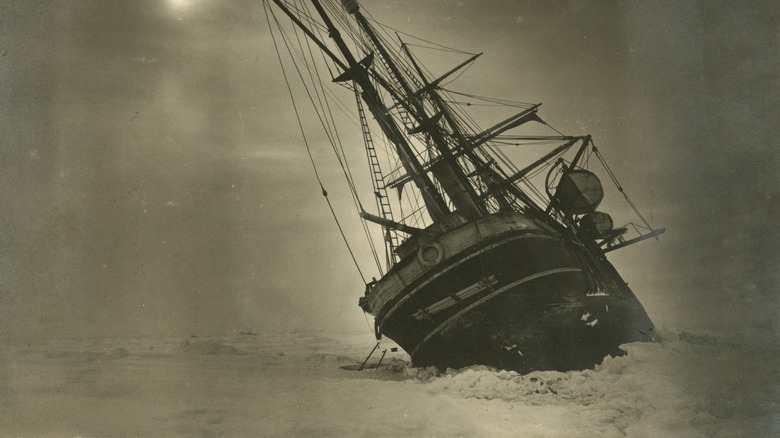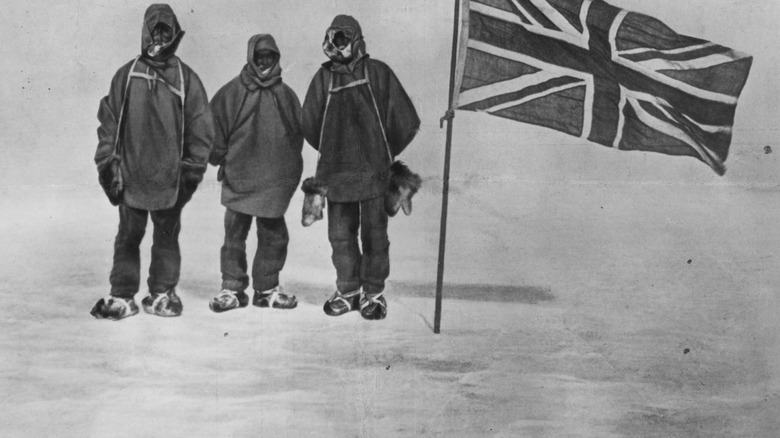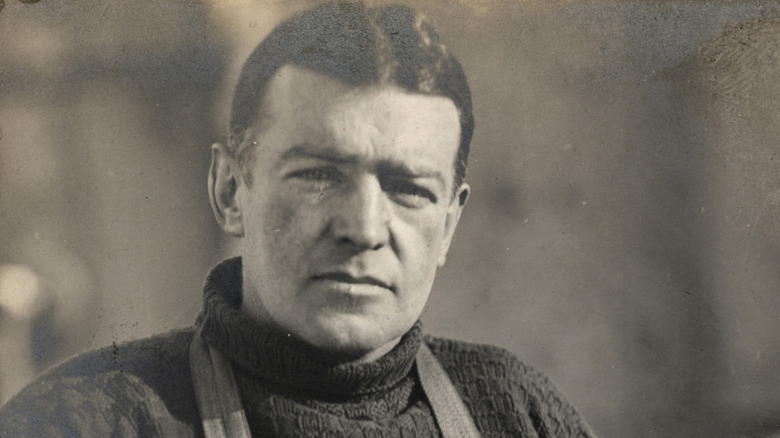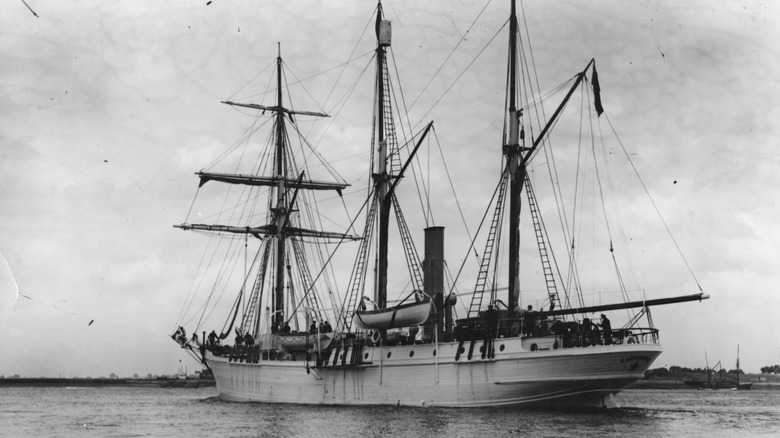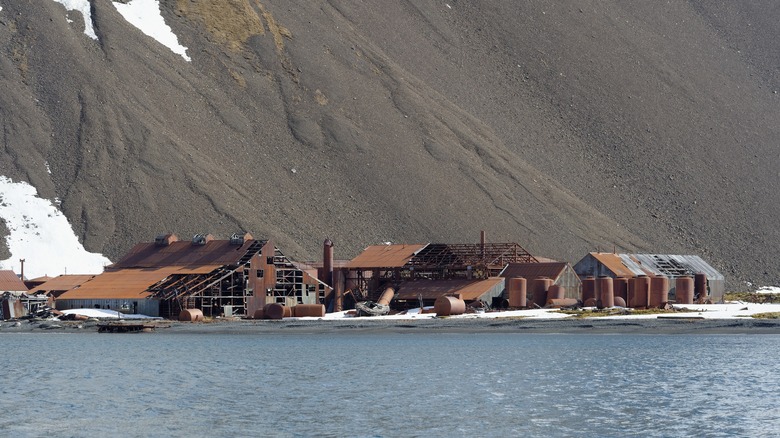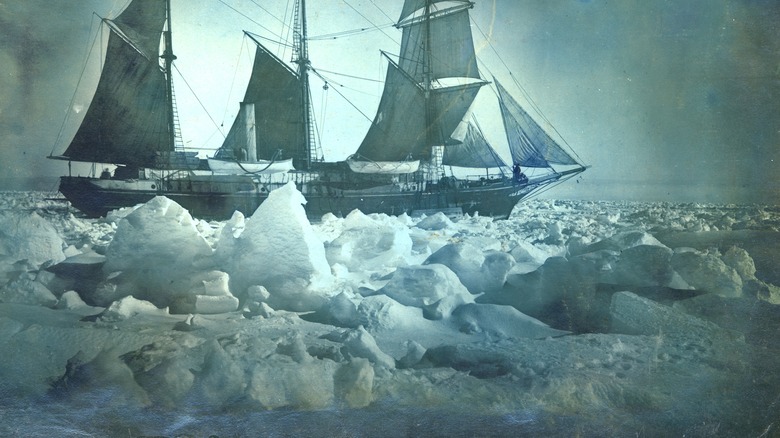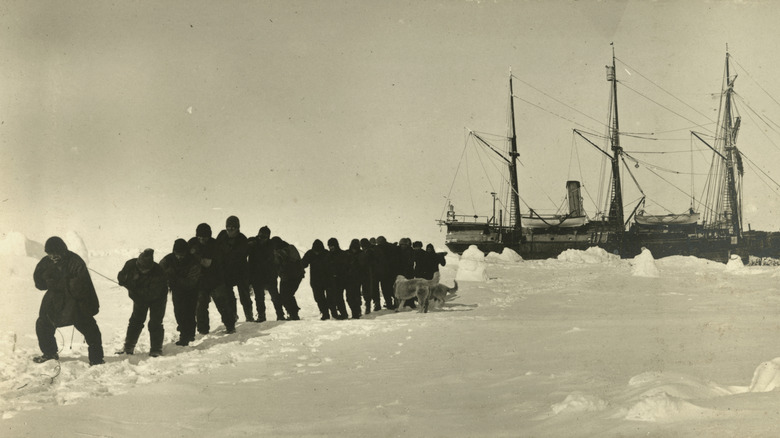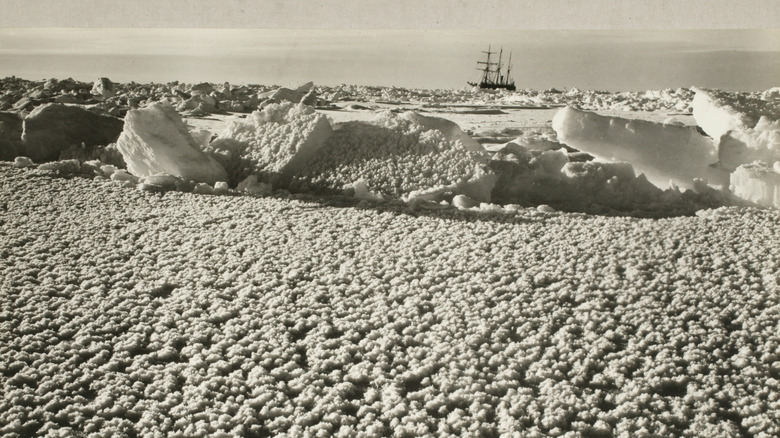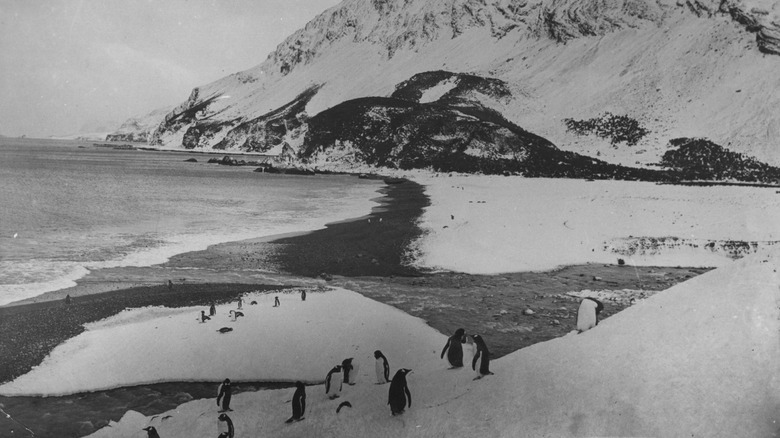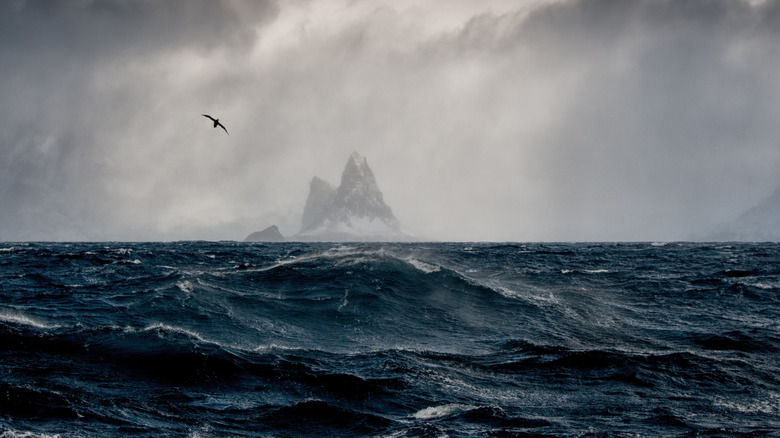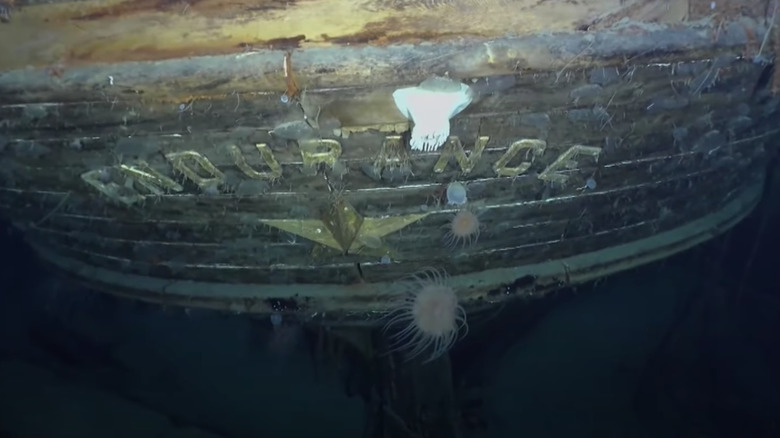Inside The Discovery Of The Endurance Shipwreck
In 1914, under the leadership of explorer Sir Ernest Shackleton, an expedition set sail from England intending to cross the entire continent of Antarctica on foot. According to Britannica, It was known as the British Imperial Trans-Antarctic Expedition, and while it wouldn't be successful in achieving its original goal, the expedition would still earn its place in history as one of the greatest survival stories ever.
What derailed the British Imperial Trans-Antarctic Expedition was the loss of their ship, Endurance, which according to The New York Times found itself caught in the ice and sank. The ship has been sitting under 10,000 feet of the coldest waters on the planet for over a century.
In 2022, another expedition — this one coming 106 years after Endurance was lost — was successful in locating the famous ship.
"Without any exaggeration, this is the finest wooden shipwreck I have ever seen — by far," marine archaeologist Mensun Bound told BBC News. "It is upright, well proud of the seabed, intact, and in a brilliant state of preservation."
Shackleton nearly makes it to the South Pole
Just a few years before the British Imperial Trans-Antarctic Expedition, Sir Ernest Shackleton was part of another Antarctic expedition. It was called the British Antarctic Expedition and it set sail in 1907 with Shackleton as the captain of the expedition ship called the Nimrod. According to Cool Antarctica, the goal of this expedition was to reach the South Pole, something that had eluded Shackleton. In 1902, he had been on another expedition that came within 480 nautical miles of reaching the South Pole. That expedition didn't end well for Shackleton, as he suffered a bout with scurvy and had to return home sooner than expected.
The Nimrod's first stop was New Zealand, and from there the ship received a tow from another ship called the Koonya. This was a measure designed to save coal so that there was plenty when the Nimrod came face to face with the Antarctic ice pack. On January 14, 1908, the Nimrod left its tow vessel and set off on its own.
By February 22 that same year, the expedition's landing party was in place and the Nimrod returned to New Zealand. The rest of the expedition was made by sleigh and on foot. However, low rations and worsening conditions required the expedition to turn around just 97 miles from the South Pole.
Shackleton's new challenge
Shackleton returned from his second Antarctic expedition in 1909. By 1911, his goal of reaching the South Pole had been achieved, just not by him. Norwegian explorer Roald Amundsen and English explorer Captain Robert Falcon Scott led competing expeditions to reach the South Pole. Amundsen reached completed the journey first — the first person to do so — while Scott made it a couple of months later, but died on the return journey (via Royal Museums Greenwich).
Shackleton needed a new challenge, but not only had others made it to the South Pole, but another expedition had also reached the North Pole. In 1909, the same year Shackleton's failed expedition returned home, American explorer Robert Peary accomplished the feat (via Britannica).
With those milestones crossed off by other explorers, Shackleton decided on attempting something far more ambitious, he wasn't just going to reach the South Pole, he was going to journey across the entire continent of Antarctica.
This wasn't Shackleton's original idea. The idea for a transcontinental expedition came from William Speirs Bruce, a Scottish explorer, who was unable to scrounge together the money for an expedition (via Undiscovered Scotland).
Endurance sets sail
The logistics of the expedition were fairly complicated. Shackleton needed two ships for the expedition so that one would be waiting on either side of the continent. He also needed a crew of over 50 men and huge amounts of supplies and equipment. His idea was going to cost a lot of money and many would-be financiers weren't so sure about whether Shackleton could pull it off. Still, he managed to raise the money, thanks in large part to a donation from Scottish industrialist Sir James Caird — one that was equal to £1,500,000 (nearly $2 million) today (via Shackleton).
Obviously, Shackleton needed a ship, and he used some of the funds he had raised to secure the Endurance, a 144-foot-long wooden vessel with three sails (The New York Times). A sister ship, the Aurora, would be responsible for dropping supplies once Shackleton and his six-man crew were on foot (via Shackleton).
The Endurance set sail from England in August 1914, and the British Imperial Trans-Antarctic Expedition was underway.
Shackleton receives a warning
According to Shackleton, The expedition made it to South Georgia — an island in the southern Atlantic Ocean — in November 1914, just a few months into the expedition. Shackleton's plan for the expedition was to take the Endurance through the Weddell Sea to the Antarctic coast, but while on South Georgia he received a warning that put that plan in jeopardy.
The Weddell Sea is notorious for its thick sea ice, per Britannica, but Shackleton was told that it was especially icy that year. Undeterred, by the warning, Shackleton chose to press on with his original plan.
The Endurance and her crew crossed the Antarctic Circle and into the icy waters of the Southern Ocean. From there, Shackleton guided his ship into the Weddell Sea. According to History, the ship was carrying 27 men including a stowaway who later became the ship's steward as well as 69 dogs and a cat. Shackleton should have heeded the warning because this decision turned out to be costly.
The Endurance becomes trapped in ice
According to History, the Endurance and her crew were encountering ice as early as two days after leaving South Georgia, which probably should have been some indication of what was ahead. For the next few months, Shackleton navigated the Endurance through narrow gaps in the increasing ice pack. However, on January 18, 1915, those gaps disappeared. Strong winds had trapped the Endurance in ice. One of the Endurance's crew members described the ship's predicament as being "frozen like an almond in the middle of a chocolate bar."
Worse yet, the ice was pushing the ship farther away from its intended landing spot which was only about one day's worth of sailing away when the ship became stuck. Alexander Macklin was one of the ship's surgeons and he later wrote Shackleton's demeanor upon being faced with such a frustrating roadblock, saying did not rage at all, or show outwardly the slightest sign of disappointment; he told us simply and calmly that we must winter in the Pack; explained its dangers and possibilities; never lost his optimism and prepared for winter."
While Shackleton may have tried to display some degree of optimism in front of his crew, he reportedly told the ship's captain Frank Worsley that "The ship can't live in this, Skipper ... It may be a few months, and it may be only a question of weeks, or even days ... but what the ice gets, the ice keeps."
There was only one thing the Endurance and her crew could do: wait it out.
'She's going, boys'
The Endurance sat stuck in the ice for months, and not only did the situation not improve, it got much, much worse. According to History, on October 27, 1915, the Endurance ran out of endurance. The pressure from the surrounding ice was too strong and it started to crush the ship. Water started flooding the Endurance. The crew rushed to save whatever they could and set up a camp on the ice near the ship.
Just 25 days after the crew had to abandon ship, the Endurance was seen for the last time, at least for over 100 years. The ship had taken on so much water that it finally sank, disappearing beneath the surface of the frigid Weddell Sea and the thick sea ice.
Shackleton's message to his crew was brief but got the point across. "Ship and stores have gone — so now we'll go home."
The crew had to make some difficult decisions in the name of survival. Any possessions that weren't going to directly aid in their survival effort had to be forgotten. Sadly, that meant some of their animals too.
The expedition crew enters survival mode
If everything had gone according to plan, Shackleton's initial estimate was that the 1,800-mile journey on foot across Antarctica would take about 120 days (via Shackleton). Once the crew became stranded and made their initial escape attempt, it was clear that Shackleton's estimate was way off.
The crew attempted to trek across the ice to land, but when they only managed to travel 7 miles in seven days, they turned back and reassessed their options. "There was no alternative," Shackleton later wrote, "but to camp once more on the floe and to possess our souls with what patience we could till conditions should appear more favorable for a renewal of the attempt to escape."
According to History, that waiting paid off, but the crew needed to act fast because cracks were starting to develop in the ice. "The floe has been a good friend to us," Shackleton said, "but it is reaching the end of its journey, and is liable at any time now to break up."
They could see Clarence and Elephant Islands, and when there was enough room they launched lifeboats and made their way toward land.
The crew makes it to dry land and Shackleton leaves to get help
The crew of the Endurance reached Elephant Island in April 1916, more than two years after they first got stuck in the Antarctic ice pack. By this point, most of the crew was in rough shape, and their outlook for being rescued wasn't great either. Elephant Island lacked resources that they would find useful and it was remote enough that passing ships were unlikely to see them (via Shackleton). If they wanted to be rescued, they needed to take matters into their own hands.
Shackleton picked a six-man crew to hop in a lifeboat with him and head back to South Georgia which according to History was 800 miles away. There they could find help. He left the rest of the crew — 22 men in total — to wait it out on Elephant Island.
After 16 days at sea, the lifeboat reached South Georgia, but there was a problem. They had planned on getting help from a whaling station on the island, but they had landed on the wrong part of the island. Shackleton and two members of the crew set off on the 36-hour journey to the whaling station.
The Elephant Island rescue
Once help had been found at the whaling station, the first stop was to pick up the three remaining members of the lifeboat crew on the far side of South Georgia, but once they were aboard they set their sights on retrieving their fellow crew members on Elephant Island. By this point, the Shackleton and his crew were no strangers to adversity, and they faced more.
According to History, the first rescue ship nearly ran out of fuel and had to abort the rescue attempt and instead go to the Falkland Islands off the coast of Argentina. The next vessel came courtesy of the government of Uruguay, but it had to turn around when the ice became too thick 100 miles from Elephant Island.
Finally, Shackleton was aboard a third ship, a Chilean vessel called the Yelcho which finally made it to Elephant Island on August 30, 1916. Miraculously all the remaining Endurance crew members were still alive. They boarded the Yelcho and started the final leg of their journey home.
The Endurance is finally recovered
106 years after the fiasco that was the British Imperial Trans-Antarctic Expedition, a new expedition — which according to The New York Times was called Endurance22 — hoping to locate the missing ship.
On March 9, 2022, it was announced that after a century the Endurance had been found. "We have made polar history with the discovery of Endurance, and completed the world's most challenging shipwreck search," said the expedition's leader John Shears.
The expedition — which worked from the icebreaker vessel S.A. Agulhas II — was able to verify the ship by using pictures that were taken before it sank. It also helped that the word "Endurance" was still clearly visible on the ship's hull.
The expedition used battery-powered submersibles to search the deep, dark, frigid Antarctic waters for the Endurance. Upon finding the ship, the submersibles didn't touch the wreckage. This was in accordance with the Antarctic Treaty, which is intended to protect the Antarctic region and names the wreck of the Endurance as a historic monument.
